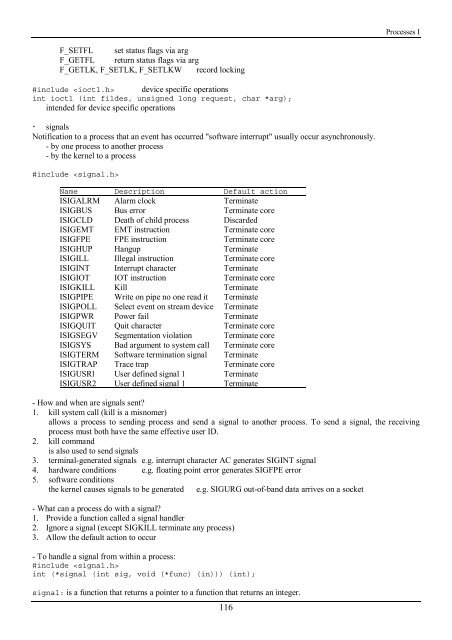You also want an ePaper? Increase the reach of your titles
YUMPU automatically turns print PDFs into web optimized ePapers that Google loves.
Processes I<br />
F_SETFL set status flags via arg<br />
F_GETFL return status flags via arg<br />
F_GETLK, F_SETLK, F_SETLKW record locking<br />
#include device specific operations<br />
int ioctl (int fildes, unsigned long request, char *arg);<br />
intended for device specific operations<br />
! signals<br />
Notification to a process that an event has occurred "software interrupt" usually occur asynchronously.<br />
- by one process to ano<strong>the</strong>r process<br />
- by <strong>the</strong> kernel to a process<br />
#include <br />
Name Description Default action<br />
ISIGALRM Alarm clock Terminate<br />
ISIGBUS Bus error Terminate core<br />
ISIGCLD Death of child process Discarded<br />
ISIGEMT EMT instruction Terminate core<br />
ISIGFPE FPE instruction Terminate core<br />
ISIGHUP Hangup Terminate<br />
ISIGILL Illegal instruction Terminate core<br />
ISIGINT Interrupt character Terminate<br />
ISIGIOT IOT instruction Terminate core<br />
ISIGKILL Kill Terminate<br />
ISIGPIPE Write on pipe no one read it Terminate<br />
ISIGPOLL Select event on stream device Terminate<br />
ISIGPWR Power fail Terminate<br />
ISIGQUIT Quit character Terminate core<br />
ISIGSEGV Segmentation violation Terminate core<br />
ISIGSYS Bad argument to system call Terminate core<br />
ISIGTERM Software termination signal Terminate<br />
ISIGTRAP Trace trap Terminate core<br />
ISIGUSRl User defined signal 1 Terminate<br />
ISIGUSR2 User defined signal 1 Terminate<br />
- How and when are signals sent?<br />
1. kill system call (kill is a misnomer)<br />
allows a process to sending process and send a signal to ano<strong>the</strong>r process. To send a signal, <strong>the</strong> receiving<br />
process must both have <strong>the</strong> same effective user ID.<br />
2. kill command<br />
is also used to send signals<br />
3. terminal-generated signals e.g. interrupt character AC generates SIGINT signal<br />
4. hardware conditions e.g. floating point error generates SIGFPE error<br />
5. software conditions<br />
<strong>the</strong> kernel causes signals to be generated e.g. SIGURG out-of-band data arrives on a socket<br />
- What can a process do <strong>with</strong> a signal?<br />
1. Provide a function called a signal handler<br />
2. Ignore a signal (except SIGKILL terminate any process)<br />
3. Allow <strong>the</strong> default action to occur<br />
- To handle a signal from <strong>with</strong>in a process:<br />
#include <br />
int (*signal (int sig, void (*func) (in))) (int);<br />
signal: is a function that returns a pointer to a function that returns an integer.<br />
116
















